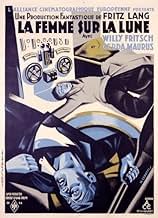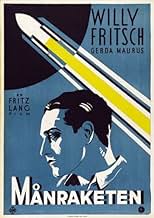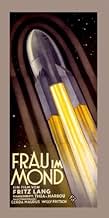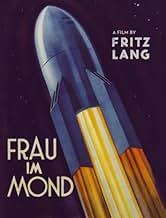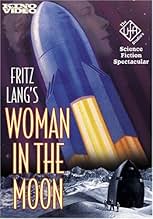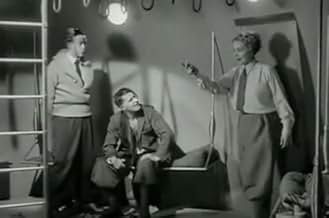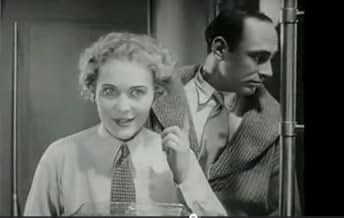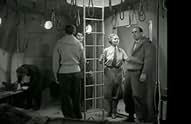CALIFICACIÓN DE IMDb
7.3/10
4.1 k
TU CALIFICACIÓN
Un científico tenaz despega hacia la Luna con la esperanza de encontrar riquezas allí.Un científico tenaz despega hacia la Luna con la esperanza de encontrar riquezas allí.Un científico tenaz despega hacia la Luna con la esperanza de encontrar riquezas allí.
- Premios
- 1 nominación en total
Gustl Gstettenbaur
- Gustav
- (as Gustl Stark-Gstettenbaur)
Gustav von Wangenheim
- Hans Windegger - Engineer
- (as Gustav v. Wangenheim)
Alexa von Porembsky
- Eine Veilchenverkäuferin
- (as Alexa v. Porembska)
Heinrich Gotho
- Der Mieter vom II. Stock
- (as Gotho)
Alfred Loretto
- Zwei eindeutige Existenzen
- (as Loretto)
Max Maximilian
- Grotjan, Chauffeur bei Helius
- (as Maximilian)
Edgar Pauly
- Zwei eindeutige Existenzen
- (as Pauly)
Karl Platen
- Der Mann am Mikrophon
- (as Platen)
Mahmud Terja Bey
- Fünf Gehirne und Scheckbücher
- (as Terja Bey)
Hermann Vallentin
- Fünf Gehirne und Scheckbücher
- (as Vallentin)
Opiniones destacadas
This was Fritz Lang's last silent film. It is a science fiction adventure in which a scientist, Professor Georg Manfeldt, had theorized that there were large supplies of gold on the moon. He was ridiculed by his peers and disgraced because of this. However, a wealthy industrialist believes Manfeldt's theory and has been building a rocket to travel to the moon. when a group of wealthy men who control the world's gold supply feel threatened by the possibility the theory may be correct, they threaten to destroy the rocket unless one of their agents, Turner, is allowed to go on the expedition too. Apparently Lang's film got so much right about space travel that the Germans seized the models used in the film as state secrets when they started their own rocket-building program. This film runs 169 minutes and is quite slow in places. It has some very interesting and thrilling scenes, but it is probably one of the weaker of Lang's films that I have seen.
One of the coolest things for any silent film buff is to discover a film that they hadn't heard of or known too much about. That's the case with Fritz Lang's restored "Woman in the Moon", in the 2004 KINO DVD release, in which the print quality is excellent and a new piano/synthesizer score has been added. As has been cited by many others here, the pacing of much of the picture is slow and the acting is occasionally melodramatic, but as was occurring with most movies in the latter days of the silents, the acting techniques were moving form the broad stage performances of early film to more controlled and realistic portrayals and most of the actors were of the latter group. In addition to the surprisingly realistic portrayal of many aspects of what would become space flight, it is interesting that the space (science fiction) aspect is not the focus of the movie. The movie deals primarily with six characters and the tensions caused by greed, love, scientific curiosity and boyish hero worship. The fact that they are making a trip to the moon to verify a theory that gold might be mined there is just the vehicle of the story. And the story itself is pretty decent, especially if you have the patience to let the movie tell it. And even though I am a fairly jaded film buff, I found myself genuinely startled and surprised at least twice by plot turns.
I love it when that happens.
Be patient. Its 169 minutes, but I think it is worth it.
I love it when that happens.
Be patient. Its 169 minutes, but I think it is worth it.
The first half of this film; the set-up of the flight, the introduction to the main characters, a love triangle, and an international conspiracy; is frankly boring. But once the flight begins, action tenses up and things get interesting.
For 1929, the science is sometimes prescient-- a three stage rocket, a vertical assembly building, and a monstrous rolling gantry crawler-- are suggestive of the Apollo program. Other times the science is more romantic, using dowsing rods and an egg-shaped moon. The eggy moon allows a far-side with a breathable atmosphere. But an eggy moon really isn't less scientific than faster than light travel, which is a staple of modern space flight science fiction. FTL travel is simply a mechanism whereby a cast of characters can visit multiple star systems; the eggy moon allows the visit to a breathable world in the context of a 1930s Europe.
This movie understandably has fairly primitive special effects. One major effect, a rotating barrel decorated as the moon, is charming.
The ending is definitely touching. In the sub-genre of science fiction/space flight, this is an important and interesting film and well worth suffering through the first half.
For 1929, the science is sometimes prescient-- a three stage rocket, a vertical assembly building, and a monstrous rolling gantry crawler-- are suggestive of the Apollo program. Other times the science is more romantic, using dowsing rods and an egg-shaped moon. The eggy moon allows a far-side with a breathable atmosphere. But an eggy moon really isn't less scientific than faster than light travel, which is a staple of modern space flight science fiction. FTL travel is simply a mechanism whereby a cast of characters can visit multiple star systems; the eggy moon allows the visit to a breathable world in the context of a 1930s Europe.
This movie understandably has fairly primitive special effects. One major effect, a rotating barrel decorated as the moon, is charming.
The ending is definitely touching. In the sub-genre of science fiction/space flight, this is an important and interesting film and well worth suffering through the first half.
I saw the original premiere presentation director's cut of this movie in January of 2003, with excellent musical accompaniment by Dennis James at the Paramount theater. Perfect, restored print, a movie that I have always wanted to see (since it was mentioned in Carlos Clarens "Horror Movies" first published in 1967). HOWEVER... The tendency toward "original, premiere presntation" director's cut reached new heights of lunacy (pun intended) with this movie. It ran more than three hours and 40 minutes! According to it's IMDB entry the original version that ran in the US was 95 minutes with longer versions (running time up to 2 and a half hours) running in Europe. At times I felt as if I had been placed in hypersleep in prep for a deep space expedition of my own! The film certainly lived up to advance billing, yet certain things, like the 45-minute opening dinner scene, were obviously way longer than they needed to be. One doesn't need to be a genius to know that after the premiere, Fritz Lang probably cut the dinner scene to about three minutes, removed whole sections, and generally tightened up an otherwise improbable story. For example, the moon is portrayed as a rather pleasant (if poorly stocked with resources for survival) beach resort. Everyone runs around in sweaters and jodhpurs, and true love seems destined to survive the wait for a return rescue rocket. Other stuff was great: the launch pad, countdown and the experience of the G forces on blastoff were, well the archetypal events for all the space operas to follow. A good movie, but probably seen to much better effect on video or in the shorter release version (if either ever turns up).
Frau im Mond may appear scientifically outlandish to the modern viewer, and the high-style expressionistic acting of its actors overdone, but nevertheless the film should be recognized as a landmark which impacted world history. The UFA studio commissioned a then small and marginal band of German amateur rocket aficionados centered around Hermann Oberth to work as technical consultants to the film's designers, and UFA even commissioned them to build a rocket to be fired at the film's premier in Berlin. The rocket wasn't completed in time, but the laboratory furnished by UFA, not to mention the heady excitement of a brush with the highest level of cinema, and the salutory infusion of unexpected cash, together set some of these young rocketeers on their life paths. These included Willy Ley, and a young Prussian aristocrat engineer named Wehrner von Braun.
When the Nazis came to power, Fritz Lang parted with his wife and partner Thea von Harbou and came to Hollywood. The production models of the liquid-fired rockets from Frau im Mond were so advanced that in 1936 the Gestapo seized them as state secrets. Werhner von Braun went on to develop the brilliant Nazi terror weapon known as the V-2. Post-war, the V-2 and its German designers begat both the American and Soviet space programs. All subsequent space history was profoundly influenced by these developments. Frau im Mond maintains its impact to the present day. For just one example-- purely as a dramatic device to build tension before the rocket's lift-off to the Moon, Fritz Lang introduced title cards counting down from ten to one. The "countdown",as it became known, was so successful that NASA and everybody else has been doing it ever since.
When the Nazis came to power, Fritz Lang parted with his wife and partner Thea von Harbou and came to Hollywood. The production models of the liquid-fired rockets from Frau im Mond were so advanced that in 1936 the Gestapo seized them as state secrets. Werhner von Braun went on to develop the brilliant Nazi terror weapon known as the V-2. Post-war, the V-2 and its German designers begat both the American and Soviet space programs. All subsequent space history was profoundly influenced by these developments. Frau im Mond maintains its impact to the present day. For just one example-- purely as a dramatic device to build tension before the rocket's lift-off to the Moon, Fritz Lang introduced title cards counting down from ten to one. The "countdown",as it became known, was so successful that NASA and everybody else has been doing it ever since.
¿Sabías que…?
- TriviaThis film shows the first countdown to the launch of a rocket - not just the first one in a movie, but the first ever. It was invented as a dramatic device for the movie. Previously, all launches were begun with a count upward from zero to a designated number (usually ten). Also depicted for the first time are the use of liquid rocket fuel, a rocket with two stages, and zero gravity in space.
- ErroresWhen Helius listens for Friede's heartbeat, fearing that the launch may have killed her, we can see her breathing heavily.
- Citas
[Opening intertitle]
The Author: "Never" does not exist for the human mind... only "Not yet."
- Créditos curiososFritz Rasp is billed in the opening credits as "Der Mann, der sich Walter Turner nennt" or "The man who calls himself Walter Turner."
- Versiones alternativasThe film was given a release from Kino Internation on DVD, running a length of 169 minutes. The 2000 restoration runs 200 minutes. The original showing in the United States ran 156 minutes and was later cut to 95 minutes.
- ConexionesEdited into Histoire(s) du cinéma: Le contrôle de l'univers (1999)
- Bandas sonorasHeimlich singt für uns die Liebe
Music by Willy Schmidt-Gentner
Lyrics by Fritz Rotter
Sung by Gerda Maurus and Willy Fritsch
Selecciones populares
Inicia sesión para calificar y agrega a la lista de videos para obtener recomendaciones personalizadas
- How long is Woman in the Moon?Con tecnología de Alexa
Detalles
- Fecha de lanzamiento
- País de origen
- Idioma
- También se conoce como
- Woman in the Moon
- Locaciones de filmación
- Productoras
- Ver más créditos de la compañía en IMDbPro
- Tiempo de ejecución
- 2h 36min(156 min)
- Mezcla de sonido
- Relación de aspecto
- 1.33 : 1
Contribuir a esta página
Sugiere una edición o agrega el contenido que falta

